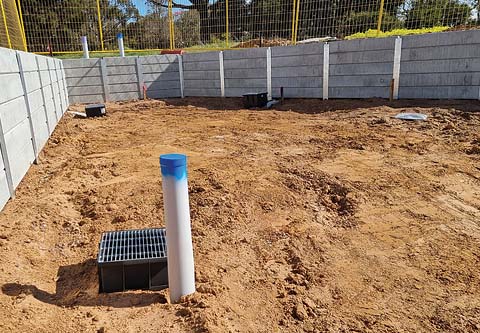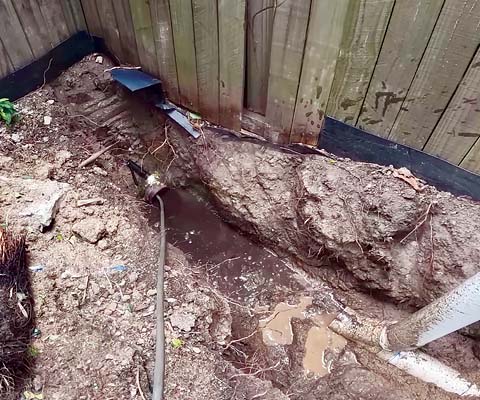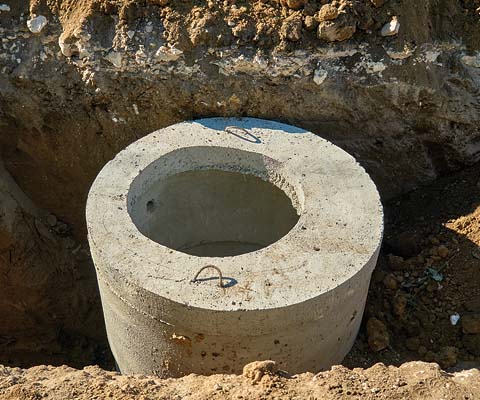Drain Plumbing Sunbury
Plumbers For Drainage Services



Drainage plays a crucial role in managing excess water from various sources, protecting infrastructure, landscapes, and ecosystems. These systems serve multiple purposes, including preventing flooding, improving water quality, and ensuring sustainability in both urban and rural environments. But more specifically in relation to buildings and property owners, drainage is how wastewater is removed safely.
Our drain plumbing services are available to both residents and businesses. Having a little bit of understanding about how drainage works allows property owners to take proactive measures in maintaining their plumbing systems, thus avoiding costly repairs and disruptions in their daily lives.
Blocked Drains And Repairs
With so many variables and possible factors involved in blocked drains, leave it to us experts.
Drainage Installations
Our plumbers provide a comprehensive drainage system installation service from start to finish.
Sunbury Drainage Services
For a drain plumber in Gisborne or Sunbury, here's what we do:
Drain Installations
For new construction builds, upgrades to existing drainage or for any type of drain installations, we are ready to help. Proper installation of drains is essential for the functionality of a building's plumbing and durability. Our drain plumbing installation services are designed to ensure that your home or business has a reliable and efficient drainage system. We have the experience you need installing drains that are durable and capable of handling varying volumes of water flow.
We offer a comprehensive range of drainage installation services, including site assessments to evaluate your specific drainage needs, the installation of different types of drains such as French drains, trench drains, and storm drains, as well as expert advice on the best options for your property.
Design Considerations
The design of drainage systems requires careful planning and consideration of various factors, including the topography, soil type, climate, and land use. Engineers and planners must assess the hydrological patterns of an area to design effective drainage solutions.
Types Of Drainage Systems
For managing wastewater and preventing flooding in residential and commercial properties, our plumbers typically install several types of drainage systems, including:
Surface Drainage Systems: These systems collect rainwater from the surface, using sloped channels or drains to direct water away from buildings and into appropriate outlets.
Subsurface Drainage Systems: Installed below ground, these systems consist of perforated pipes surrounded by gravel or other materials that allow water to seep through and be transported away from the foundation.
French Drains: A specific type of subsurface system, French drains utilise a trench filled with gravel and a perforated pipe to divert groundwater away from areas prone to flooding.
Stormwater Drainage Systems: Designed to handle excess rainwater, these systems usually comprise a network of pipes, trenches, and catch basins to collect and direct stormwater to nearby bodies of water or underground reservoirs.
Gravity Drains: These systems rely on the natural force of gravity to move wastewater away from the source. They need to be installed at an angle, typically a slope of 1-2%, to facilitate the flow of water.
Sump Pumps: While not a drainage system in the traditional sense, sump pumps are critical in areas susceptible to flooding. They collect excess water in a sump basin and pump it away, protecting basements and lower levels from water damage.
Understanding the various types of drainage systems can help property owners choose the right one for their specific needs, ensuring efficient water management and protection from potential damage.
Drainage System Installation Process
Installing a drainage system typically involves several steps:
Planning: Before any installation begins, assessing the area and determining the most effective drain system is essential. Factors such as the soil type, landscaping, and proximity to structures influence this decision.
Excavation: Once a plan is established, the area must be excavated. This involves digging trenches or holes to lay down pipes or install sump basins, ensuring the correct slope to facilitate water flow.
Installation: With excavation complete, the next step is to install the drainage system. This includes laying pipes, positioning sump pumps, and putting in place any necessary gravel or rock for drainage efficiency.
Backfilling and Testing: After the primary installation, the area will be backfilled and compacted. Testing the drainage system is vital to confirm it's functioning correctly before finalising the installation.
Maintenance: Regular maintenance is paramount for any drainage system. This can include clearing debris from surface drains, checking pump functionality, and monitoring for signs of blockages.
Professionally designed and installed drainage systems greatly enhance the longevity and safety of buildings. For any assistance relating to a drain installation you can message or call us anytime.
Blocked Drain Plumbing Services
Blocked drains pose a common issue for both residential and commercial properties, potentially leading to serious plumbing problems if not addressed quickly. These obstructions can stem from a variety of causes, including the accumulation of debris, tree roots and the improper disposal of waste. And we’ve seen it all.
The signs of a blocked drain can often be subtle at first, with slow-draining sinks or gurgling noises being the initial warning flags. However, as the blockage worsens, more severe symptoms such as overflowing toilets or stagnant water pooling in sinks, showers, and outdoor areas may appear. Such conditions not only disrupt daily routines but can also lead to unpleasant odours and hygiene concerns. You should be contacting us before it gets to this stage, that’s why understanding the warning signs is important.
Our blocked drain plumbers are equipped with the necessary skills, tools, and experience to tackle drainage issues effectively. We typically start by conducting a thorough inspection of the plumbing system, using cameras to confirm the blockage. We identify the exact location and nature of the blocked drain. From there, we would either use a drain snake, a plunger or hydrojet if needed. High-pressure water jetting, involves using a pressurised stream of water to flush out debris and buildup within the pipes, effectively restoring flow and preventing future blockages.
Our CCTV Drain Inspection Services
At the forefront of drainage solutions, our CCTV drain inspection services combine state-of-the-art technology with expertise to provide thorough evaluations of your drainage systems. We offer an efficient approach to identifying problems without intrusive measures.
What Is A CCTV Drain Inspection?
CCTV (Closed Circuit Television) drain inspection involves the use of high-definition cameras mounted on flexible rods that are inserted into your drainage systems. This innovative technique allows us to capture detailed images and videos of the interior of pipes and drains, providing insights into the condition and functionality of your drainage system. Unlike traditional methods, CCTV inspections are non-destructive, causing minimal disruption to your property.
Benefits Of CCTV Drain Inspections
One of the primary advantages of CCTV drain inspection is its ability to locate problems quickly and accurately. This method can reveal a variety of issues, including blockages, cracks, collapses, and root intrusions. By identifying the exact location and nature of the problem, we can significantly lower the cost and time needed for repairs.
Additionally, CCTV inspections offer a comprehensive view of the drainage system's health. They can help in identifying preventative maintenance needs, allowing you to address potential issues before they escalate into major problems. This proactive approach not only protects your property but also extends the lifespan of your drainage systems.
Other Drain Repair Services
There are many reasons why water isn’t flowing down the drains properly. Here are some other types of issues and repairs a plumber performs to restore a drainage system.
Backups: Addressing issues that cause sewage backups and ensuring proper flow.
Slow Drains: Diagnosing and resolving causes of slow draining in sinks, tubs, and showers.
Improper Drainage: Fixing drains that do not effectively channel water away from structures.
Grease Traps Maintenance: Cleaning grease traps in commercial settings to prevent clogs.
Sump Pump Repairs: Fixing or replacing sump pumps to prevent flooding in basements.
Contact Us For Drain Plumbing Services
By understanding the common drain issues and the importance of regular maintenance, property owners can take proactive steps to ensure their plumbing systems remain in good working order.
If you need any help from a Sunbury or Gisborne drain plumber, give us a call today.

